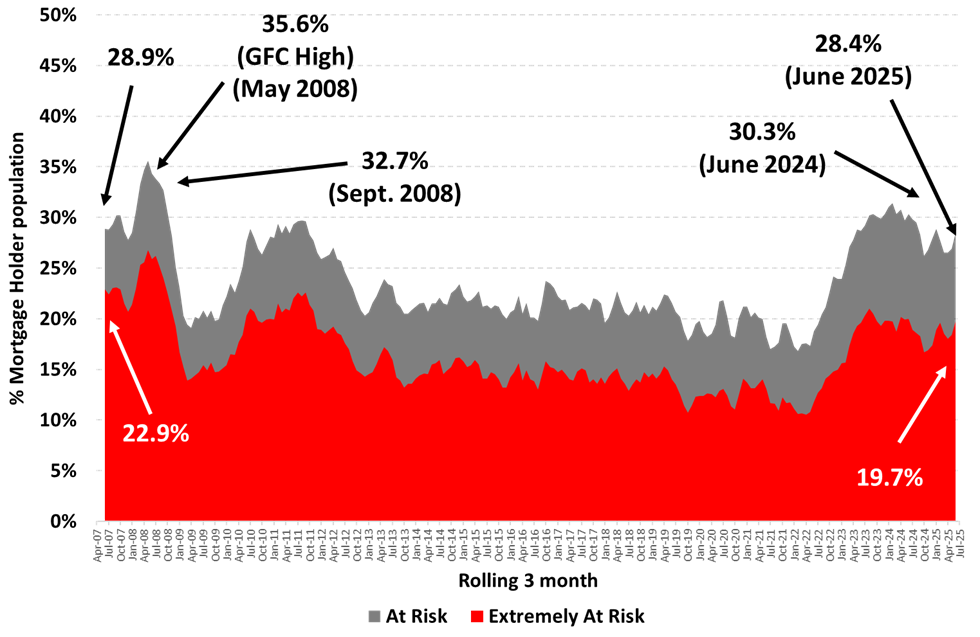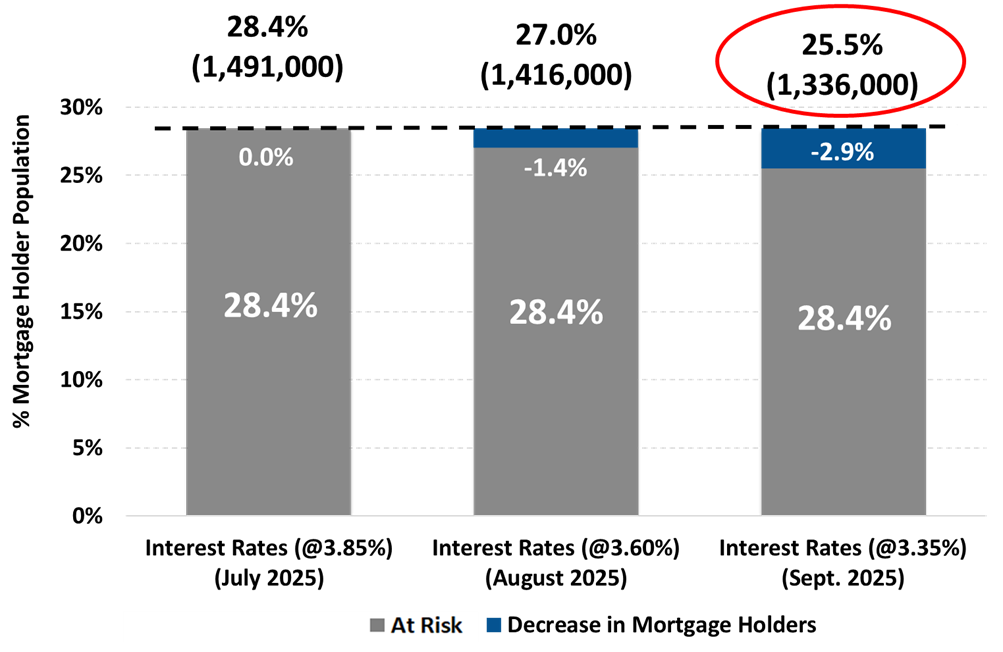Risk of mortgage stress up in June as Australians take out bigger mortgages after interest rate cuts

New research from Roy Morgan shows 28.4% of mortgage holders ‘At Risk’ of ‘mortgage stress’ in the three months to June 2025, up 1.5% points from a month earlier. This is the highest rate of mortgage stress since January 2025 – before either of the Reserve Bank’s interest rate cuts.
The share of mortgage holders ‘At Risk’ of ‘mortgage stress’ in June (28.4% of mortgage holders) has increased significantly from a month earlier, up 1.5% points from May and the highest since January 2025 (28.9%). The Reserve Bank cut interest rates in February (-0.25%) and again in May (-0.25%) to 3.85% but did not meet in June before deciding to leave interest rates unchanged in early July.
The primary driver of the rise in mortgage stress in June was the larger borrowing amounts taken out by people purchasing a home and the larger amounts outstanding on home loans generally.
The record high of 35.6% of mortgage holders in mortgage stress was reached in mid-2008.
684,000 more ‘At Risk’ of mortgage stress three years after interest rate increases began
The number of Australians ‘At Risk’ of mortgage stress has increased by 684,000 since May 2022 when the RBA began a cycle of interest rate increases.
The number of Australians considered ‘Extremely At Risk’, is now numbered at 1,032,000 (19.7% of mortgage holders) which is significantly above the long-term average over the last 10 years of 14.8%.
Mortgage Stress – % of Owner-Occupied Mortgage-Holders

Source: Roy Morgan Single Source (Australia), average interviews per 3 month period April 2007 – June 2025, n=2,870.
Base: Australians 14+ with owner occupied home loan.
Mortgages ‘At Risk’ set to drop if the Reserve Bank cuts interest rates in August and September
Due to the decline in inflation over the last year the Reserve Bank has now cut interest rates in February and again in May by a total of 0.5% to 3.85%. Roy Morgan has modelled the impact of an additional RBA interest rate decrease in both August and September 2025 by +0.25% in both months to 3.35%.
In June, 28.4% of mortgage holders, 1,491,000, were considered ‘At Risk’ and this figure is projected to remain unchanged in July after the Reserve Bank left interest rates unchanged 3.85%.
If the Reserve Bank cuts interest rates in August by 0.25% to 3.6%, the number of mortgage holders expected to be ‘At Risk’ is forecast to decrease by 75,000 to 1,416,000 (27% of mortgage holders, down 1.4% points).
Another interest rate cut in September of 0.25% to 3.35% will have a significant impact on mortgage stress and reduce the share of mortgage holders considered ‘At Risk’ to 25.5% of mortgage holders, equivalent to 1,336,000 mortgage holders – a drop of 2.9% points, or 155,000 mortgage holders, from current figures.
Mortgage Risk projections based on an interest rate cuts in August and September to 3.35%

Source: Roy Morgan Single Source (Australia), April – June 2025, n=3,358.
Base: Australians 14+ with owner occupied home loan.
How are mortgage holders considered ‘At Risk’ or ‘Extremely At Risk’ determined?
Roy Morgan considers the risk of ‘mortgage stress’ among mortgage holders in two ways:
Mortgage holders are considered ‘At Risk’[1] if their mortgage repayments are greater than a certain percentage of household income – depending on income and spending.
Mortgage holders are considered ‘Extremely at Risk’[2] if even the ‘interest only’ is over a certain proportion of household income.
Unemployment is the key factor which has the largest impact on income and mortgage stress
It is worth understanding that Roy Morgan uses a conservative forecasting model, essentially assuming all other factors apart from interest rates remain the same.
The latest Roy Morgan unemployment estimates show over one-in-five Australian workers are either unemployed or under-employed – 3,233,000 (20.3% of the workforce); (In June Australian unemployment dropped to 10.4% driven by rise in new jobs – especially full-time jobs).
Although the Reserve Bank’s decision to cut interest rates in February and May has clearly had a positive impact and helped marginally lower mortgage stress, the fact remains the greatest impact on an individual, or household’s, ability to pay the mortgage is not interest rates, it’s if they lose their job or main source of income.
Michele Levine, CEO Roy Morgan, says the impact of the Reserve Bank’s (RBA) interest rate cuts has marginally reduced levels of mortgage stress but has also led to larger loan sizes for home borrowers – putting upward pressure on mortgage stress despite the interest rate cuts:

“The latest Roy Morgan data shows 1,491,000 Australians ‘At Risk’ of mortgage stress in June 2025 equivalent to 28.4% of mortgage holders ‘At Risk’ (up 1.5% points since May 2025).
“This is the highest level of mortgage stress since January 2025 (28.9% of mortgage holders), and since the Reserve Bank (RBA) cut interest rates from a 13-year high of 4.35% in February 2025. The RBA made an additional interest rate cut in May 2025 to a two-year low of 3.85%, didn’t meet in June, and left interest rates unchanged at its most recent meeting in early July.
“However, although these interest rate cuts have reduced interest rates in the last few months, the latest figures for June show an increase in levels of mortgage stress due to mortgagors borrowing larger amounts and having larger amounts outstanding on existing loans while income growth remains more modest.
“This is not surprising when one considers other data sources which show national house prices in Australia. The ABS ‘Total Value of Dwelling’ release showed average dwelling prices in Australia exceeding $1 million for the first time in the March quarter 2025, and more recent market figures show that figure continuing to increase to new record highs in recent months.
“Looking around Australia, the latest ABS figures show average dwelling prices in New South Wales are well above the national average at $1.25 million in the March quarter 2025 followed by Queensland ($945,000), ACT ($941,000), Victoria ($900,000) and Western Australia ($874,000).
“Unsurprisingly given these figures, its not a shock to learn that mortgage stress is highest in New South Wales with almost a third of people with a mortgage ‘At Risk’ of mortgage stress. Mortgage stress is also high in Victoria and has increased significantly in Queensland in recent months
“These results show although reducing interest rates generally does lead to lower levels of mortgage stress, this effect may only be short-term as new buyers entering the market are able to borrow more money for larger loans to get into the market, thus leading to an increase in mortgage stress.
“The good news for those already with a mortgage is that the latest ABS monthly inflation estimates for May 2025 showed annual inflation at 2.1%, well below the mid-point of the RBA’s preferred target range of 2-3%. This is the tenth straight month the official inflation estimates have been within the RBA’s preferred target range of 2-3% – and set to lead to further interest rate cuts.
“Finally, it is important to appreciate that interest rates are only one of the variables that determines whether a mortgage holder is considered ‘At Risk’ – the largest impact on whether a borrower falls into the ‘At Risk’ category is related to household income – which is directly related to employment.
“The employment market has been strong over the last three years (the latest Roy Morgan estimates show around 1 million new jobs created compared to May 2022) and this has provided support to household incomes which have helped to moderate levels of mortgage stress over the last year.”
These are the latest findings from Roy Morgan’s Single Source Survey, based on in-depth interviews conducted with over 60,000 Australians each year including over 10,000 owner-occupied mortgage-holders.
To learn more about Roy Morgan’s mortgage data, call (+61) (3) 9224 5309 or email askroymorgan@roymorgan.com. Please click on this link to the Roy Morgan Online Store.
About Roy Morgan
Roy Morgan is Australia’s largest independent Australian research company, with offices in each state, as well as in the U.S. and U.K. A full-service research organisation, Roy Morgan has over 80 years’ experience collecting objective, independent information on consumers.
[1] "At Risk" is based on those paying more than a certain proportion of their after-tax household income (25% to 45% depending on income and spending) into their home loan, based on the appropriate Standard Variable Rate reported by the RBA and the amount they initially borrowed.
[2] "Extremely at Risk" is also based on those paying more than a certain proportion of their after-tax household income (25% to 45% depending on income and spending) into their home loan, based on the Standard Variable Rate set by the RBA and the amount now outstanding on their home loan.
Margin of Error
The margin of error to be allowed for in any estimate depends mainly on the number of interviews on which it is based. Margin of error gives indications of the likely range within which estimates would be 95% likely to fall, expressed as the number of percentage points above or below the actual estimate. Allowance for design effects (such as stratification and weighting) should be made as appropriate.
| Sample Size | Percentage Estimate |
| 40% – 60% | 25% or 75% | 10% or 90% | 5% or 95% | |
| 1,000 | ±3.0 | ±2.7 | ±1.9 | ±1.3 |
| 5,000 | ±1.4 | ±1.2 | ±0.8 | ±0.6 |
| 7,500 | ±1.1 | ±1.0 | ±0.7 | ±0.5 |
| 10,000 | ±1.0 | ±0.9 | ±0.6 | ±0.4 |
| 20,000 | ±0.7 | ±0.6 | ±0.4 | ±0.3 |
| 50,000 | ±0.4 | ±0.4 | ±0.3 | ±0.2 |



